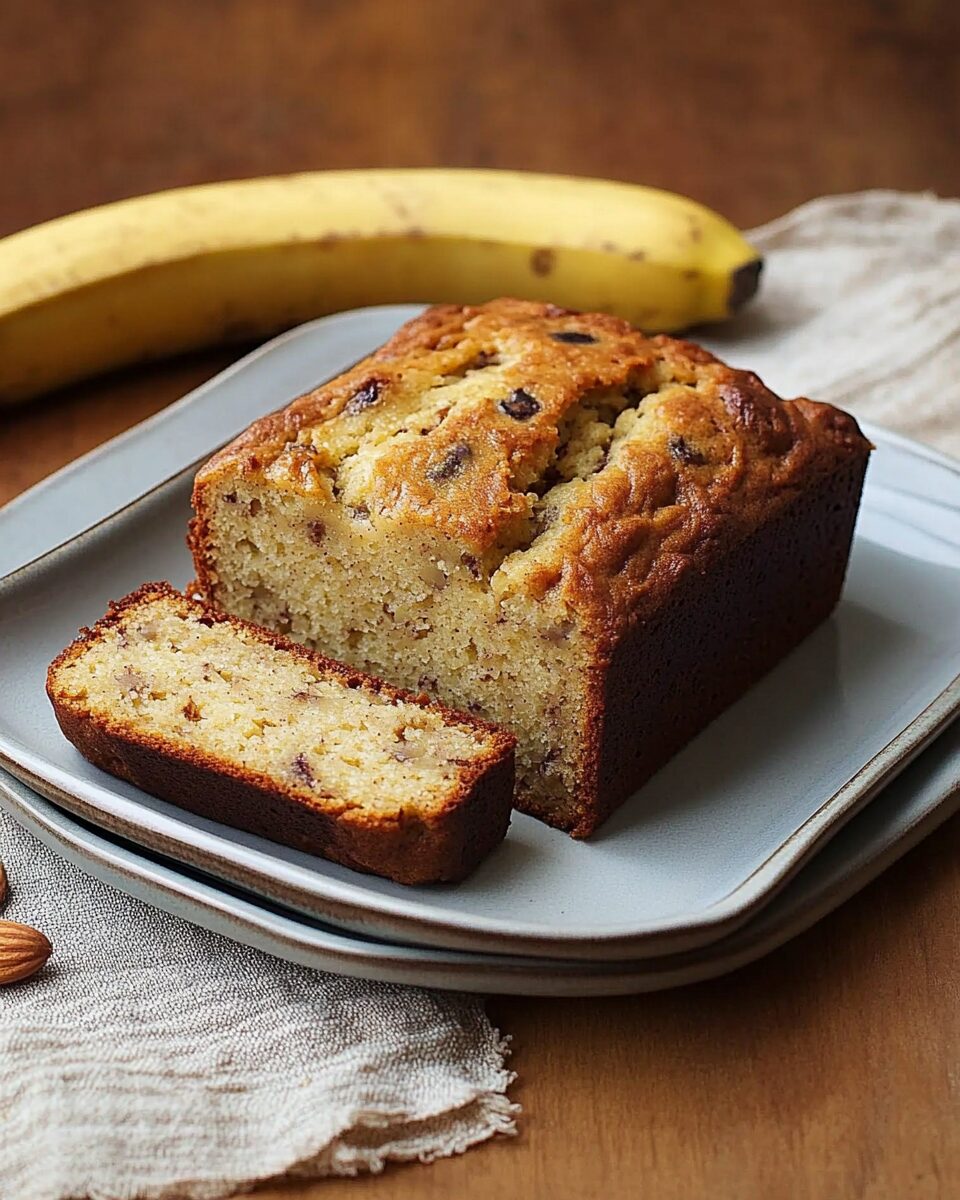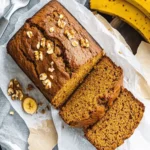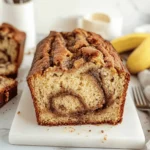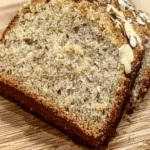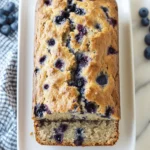A moist, naturally gluten-free banana bread made with almond flour, perfect for a healthy treat or breakfast. This recipe uses ripe bananas, almond flour, and a few wholesome ingredients to deliver a subtly sweet, rich flavor with a tender texture.
FULL RECIPE
Ingredients
- 3 ripe bananas, mashed
- 3 large eggs
- 2 cups almond flour
- 1/4 cup maple syrup or honey
- 1 teaspoon vanilla extract
- 1/2 teaspoon cinnamon
- 1 teaspoon baking soda
- 1/4 teaspoon salt
- Optional: 1/2 cup chopped walnuts or dark chocolate chips
Directions
- Preheat the oven to 350°F (175°C). Line a loaf pan with parchment paper or lightly grease it.
- In a large bowl, mash the bananas until smooth.
- Add eggs, maple syrup (or honey), and vanilla extract. Stir until well combined.
- Mix in the almond flour, cinnamon, baking soda, and salt until fully incorporated.
- Fold in optional add-ins like walnuts or chocolate chips, if using.
- Pour the batter into the prepared loaf pan and smooth the top.
- Bake for 45–55 minutes or until a toothpick inserted in the center comes out clean.
- Let cool in the pan for 10 minutes, then transfer to a wire rack to cool completely before slicing.
Nutritional Information
- Calories: 210 per slice (based on 10 slices)
- Protein: 6g
- Carbohydrates: 15g
- Fat: 14g
- Fiber: 3g
- Sugar: 9g
Health Benefits of Almond Flour in Banana Bread
Almond flour is a nutrient-dense alternative to traditional wheat flour that offers numerous health benefits. It is naturally gluten-free and lower in carbohydrates, making it ideal for those with gluten sensitivities or following low-carb diets. Almond flour is rich in healthy fats, primarily monounsaturated fats, which support heart health by helping to lower bad cholesterol levels. It also contains vitamin E, an antioxidant that protects cells from oxidative damage and supports skin health. Additionally, almond flour provides a good amount of protein and fiber, contributing to better satiety and blood sugar regulation.
The Role of Bananas in Nutrition and Flavor
Bananas add natural sweetness and moisture to this almond flour banana bread, reducing the need for added sugars. They are an excellent source of potassium, which helps maintain healthy blood pressure levels. Bananas also supply vitamin C, vitamin B6, and dietary fiber, promoting digestive health. Their creamy texture when mashed contributes to the soft, tender crumb of the bread. The natural sugars in bananas caramelize during baking, enhancing the bread’s flavor with subtle sweetness and complexity.
Gluten-Free Baking Challenges and Tips
Baking with almond flour differs significantly from wheat flour because almond flour lacks gluten, which provides elasticity and structure. This absence means the bread may be denser and more delicate than traditional banana bread. To combat this, recipes often include eggs, which act as binding agents and add moisture. It’s essential to avoid overmixing the batter to maintain a light texture. Also, baking times may vary, so monitoring the bread closely as it bakes is important to avoid dryness or undercooked centers.
Sweeteners: Choosing Maple Syrup or Honey
Maple syrup and honey are natural sweeteners that complement the flavors of banana and almond well. Unlike refined sugars, these sweeteners contain trace vitamins and minerals. Maple syrup provides manganese and zinc, which support immune function and metabolism. Honey has antibacterial properties and contains antioxidants. Both options add moisture to the bread, resulting in a softer texture. The choice between the two depends on personal preference and dietary considerations such as veganism, as honey is not considered vegan.
The Impact of Cinnamon on Flavor and Health
Adding cinnamon not only enhances the taste with its warm, spicy notes but also offers health benefits. Cinnamon contains antioxidants and anti-inflammatory compounds that may help reduce blood sugar levels and improve insulin sensitivity. Its distinctive flavor pairs naturally with banana and almond, creating a comforting, aromatic bread. The small quantity used in the recipe ensures a balanced flavor without overpowering the other ingredients.
Eggs as a Binding and Leavening Agent
Eggs play a crucial role in gluten-free banana bread by binding the ingredients together and helping the bread rise. They provide structure and moisture, contributing to a tender yet firm crumb. Eggs also enrich the bread with protein, which helps improve satiety. When baked, the proteins in eggs coagulate, giving the bread its shape and preventing it from crumbling too easily.
Nutritional Profile Compared to Traditional Banana Bread
Banana bread made with almond flour typically has fewer carbohydrates and more healthy fats compared to traditional banana bread made with wheat flour and butter. This makes it a more balanced option for those monitoring their carb intake or seeking sustained energy release. The fiber content from almond flour and bananas helps regulate digestion and blood sugar spikes. Overall, this almond flour version can be considered a more nutrient-dense, lower-glycemic alternative.
Storage and Shelf Life
Because almond flour banana bread contains more moisture and fats, it can have a slightly shorter shelf life than traditional bread. It is best stored in an airtight container at room temperature for up to three days. For longer storage, refrigerate it for up to a week or freeze it for up to three months. When freezing, slice the bread first so you can thaw individual portions. Thaw at room temperature or gently warm slices before serving to restore moisture and flavor.
Variations for Dietary Preferences
This recipe is versatile and can be adapted for different dietary needs. For a vegan version, flax or chia eggs can replace chicken eggs, though the texture may be slightly different. The sweetener can be swapped with coconut sugar or a low-glycemic sugar substitute for diabetics. Adding seeds like pumpkin or sunflower seeds can boost nutrient content and add crunch. Incorporating spices such as nutmeg or ginger can offer additional flavor profiles without extra calories.
Incorporating Nuts and Chocolate Chips
Optional additions like walnuts or dark chocolate chips enhance texture and flavor. Walnuts add crunch and healthy omega-3 fatty acids, which are beneficial for brain and heart health. Dark chocolate chips contribute antioxidants and a touch of indulgent sweetness with less sugar than milk chocolate. Both additions elevate the sensory experience of the bread, making it suitable as a special treat or dessert.
The Science Behind Baking Temperature and Time
Baking at 350°F (175°C) provides an optimal balance between cooking the bread evenly and allowing the interior to set without burning the exterior. Almond flour can brown quickly due to its higher fat content, so monitoring the bread towards the end of baking is important. Using a toothpick test ensures the center is fully cooked but not dry. Lower temperatures or longer baking times may be needed if your oven runs hot or if you add moist ingredients.
The Environmental Impact of Using Almond Flour
Almond flour, while healthy, does have an environmental footprint due to the water-intensive nature of almond farming. Compared to wheat, almond production requires significantly more water, which is a consideration in drought-prone regions. However, choosing sustainably farmed almonds or organic options can help reduce this impact. Using almond flour occasionally as part of a varied diet balances enjoyment and sustainability.
How to Enhance Moisture Without Adding Excess Fat
Maintaining moisture in gluten-free banana bread can be challenging. This recipe relies on ripe bananas, eggs, and natural sweeteners to provide sufficient moisture. Some bakers add unsweetened applesauce or Greek yogurt to increase softness without adding unhealthy fats. These ingredients contribute to a tender crumb while keeping the bread nutritious and balanced.
Pairing Suggestions for Almond Flour Banana Bread
Almond flour banana bread pairs well with a variety of toppings and beverages. A spread of natural nut butter enhances the almond flavor and adds protein. Cream cheese or Greek yogurt provide a creamy contrast to the bread’s texture. For drinks, a cup of coffee or herbal tea complements the bread’s warm, comforting spices. It also works well as a breakfast item or midday snack, offering a good balance of energy and flavor.
Using Ripe Bananas for Optimal Flavor
The ripeness of bananas directly affects the sweetness and moisture of the bread. Overripe bananas with brown spots are ideal because their starches have converted to sugars, providing natural sweetness and softness. Using underripe bananas results in a less flavorful and drier loaf. Properly ripe bananas also help reduce the amount of added sweetener needed, keeping the recipe healthier.
Almond Flour Texture and Its Effect on Bread Consistency
Almond flour is coarser and moister than traditional flour, which contributes to the dense yet tender texture of this banana bread. Its natural oils add richness, but the heavier crumb means the bread won’t rise as much. Sifting almond flour before mixing can help avoid clumps and improve the evenness of the batter. The texture makes this bread hearty and satisfying, especially when paired with crunchy add-ins.
Potential Allergies and Substitutions
Because almond flour is made from tree nuts, this recipe is not suitable for those with nut allergies. For nut-free options, coconut flour or oat flour blends can be used, but these require recipe adjustments due to their different absorbency and texture. Always communicate potential allergens clearly when serving to others. The natural sweetness and moisture can still be achieved with alternative flours and egg substitutes.
The Cultural Popularity of Banana Bread
Banana bread has become a beloved comfort food in many cultures, especially in North America, where it rose to prominence during the 20th century. Its popularity surged during times of food rationing as a way to use overripe bananas and avoid waste. The almond flour variation represents a modern twist, catering to health-conscious consumers and those with dietary restrictions while maintaining the nostalgic appeal.
Baking Tools and Equipment Tips
Using the right equipment can improve results when making almond flour banana bread. A sturdy loaf pan ensures even baking and easy removal. Silicone or parchment liners prevent sticking and reduce cleanup. A stand mixer or hand mixer can help combine ingredients thoroughly but avoid overmixing. A good-quality oven thermometer ensures accurate temperature control, which is crucial for gluten-free baking.
Common Mistakes to Avoid
A few pitfalls can affect the outcome of almond flour banana bread. Overmixing the batter can cause a dense, tough texture. Using unripe bananas leads to bland flavor and dryness. Skipping the baking soda will reduce rise and result in a heavy loaf. Also, underbaking may leave the center gummy, while overbaking dries out the bread. Careful attention to ingredient quality and baking time is key.
Conclusion
Almond flour banana bread is a delicious, nutritious alternative to traditional banana bread, catering to gluten-free and low-carb diets while maintaining rich flavor and moist texture. Its combination of wholesome ingredients like ripe bananas, almond flour, natural sweeteners, and warm spices creates a comforting treat suitable for any time of day. By understanding the science behind its ingredients and baking process, you can customize and perfect this recipe to suit your taste and dietary needs. With proper storage and thoughtful additions, this banana bread offers a satisfying balance of health benefits and indulgence that can be enjoyed by many.

